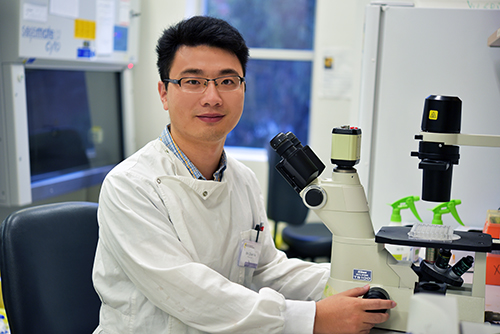
A new research study is looking to improve the lives of people with diabetes by developing a matchstick-size nano-implant that removes the need for daily insulin injections.
University of Queensland researchers at the Australian Institute for Bioengineering and Nanotechnology (AIBN) have received funding from Diabetes Australia to perform the study.
AIBN researcher Dr Chun Xu said the system would be safer to use, by regulating blood-glucose at optimal levels and eliminating the risk of hypoglycaemia.
“Diabetes is a condition where a person’s body doesn’t create enough insulin, which is an important hormone that converts glucose – or sugar – in the body to energy,” Dr Xu said.
“Many people with diabetes need to inject insulin multiple times a day, which can be painful and uncomfortable, and risks creating hypoglycaemia by injecting too much insulin. Hypoglycaemia can lead to comas or even worse complications.”
“The matchstick sized nano-implant could be implanted under the skin and control the blood glucose level up to months with just one injection, and automatically release insulin in response to diabetic glucose levels.
“In the future we would also like to develop an inter-changeable cartridge system which people could self-administer.”
Diabetes Australia’s 2016 “State of the Nation” report found that more than 380,000 Australians with type 1 and 2 diabetes need daily insulin injections, or use insulin pump therapy. With nearly 119,000 Australians living with type 1 diabetes, the vast majority of Australians injecting insulin daily live with type 2 diabetes.
Dr Xu said people with diabetes risk further complications from current treatments, necessitating the need for newer approach to treating diabetes.
“Managing diabetes can be time consuming, and there is a constant threat to health, especially in type 1 diabetes,” he said.
“It is very easy to miss an insulin injection, which can result in hyperglycaemia and having blood-glucose levels which are too high.
“This leads some people to use closed-loop insulin pumps to electronically manage insulin levels. However, these can be uncomfortable to wear, and are prone to infection because they are connected directly into the body.”
Diabetes Queensland CEO Michelle Trute said she was aware of the many pressures on members’ hip pockets, which made selection of the most promising projects critical.
“The likelihood that daily insulin injections could be made unnecessary by this research has the potential to change our members’ lives,” Ms Trute said. “It would be the start of a new dawn in the treatment of diabetes.”
Project leader Professor Chengzhong (Michael) Yu said the nano-implant would contain nanoparticles loaded with insulin, which would be released when a novel chemical biosensor is activated.
“The outside of the nanoparticle is coated with enzymes and polymer that act as a barrier to contain the insulin under normal conditions. The barrier opens to release insulin only when the blood glucose level is higher than normal, and then closes once glucose levels return to safe levels,” Professor Yu said.
“Chun’s novel design can precisely control the glucose concentration that opens this gate, which is difficult to achieve using conventional methods.”
The funding will enable to research team to study the effectiveness of the system in a mouse model, ahead of human safety trials. The study will be performed in collaboration with endocrinology expert Professor Chen Chen from UQ’s School of Biomedical Sciences.
Research into the glucose-responsive nano-implant is part of a suite of precision nanomedicine projects being studied as one of AIBN’s Five Pillars of Research.
Media: AIBN Communications, communications@aibn.uq.edu.au, +61 7 3346 3962, +61 427 148 187; Professor Michael Yu, c.yu@uq.edu.au, +61 7 3356 3283.
This story was featured on Channel 7 News on the 13th February 2017



